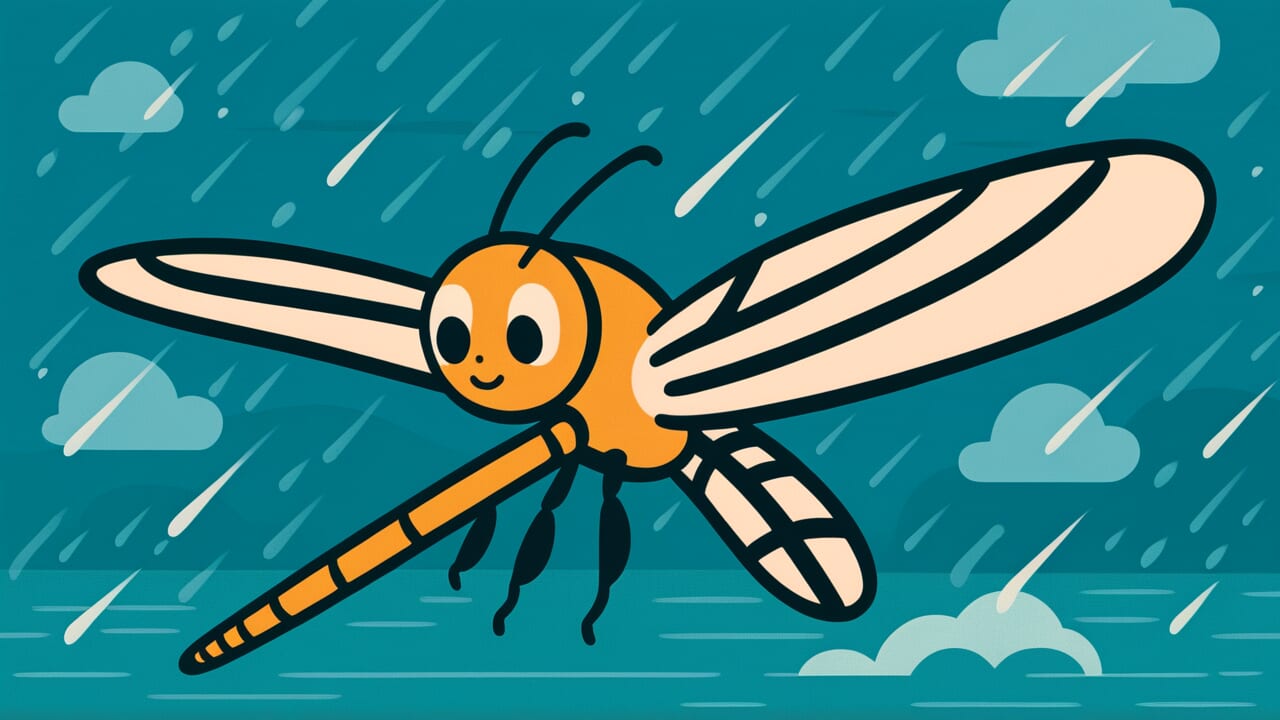How to Read “When dragonflies fly low, it will rain”
Tonbo ga hikuku tobu to ame
Meaning of “When dragonflies fly low, it will rain”
This proverb represents weather prediction wisdom. When you see dragonflies flying lower than usual, rain will likely come soon.
People in the past had no weather instruments. They read weather changes from animal and insect behavior instead.
Dragonflies fly low because of changes in air pressure and humidity. Small insects that dragonflies eat start flying lower. The dragonflies follow their prey down to lower heights.
This proverb served as a practical guide for farm work and planning outdoor activities. People used natural signs to predict the weather.
Even today, with weather radar and forecasts, this wisdom still has value. Reading weather from living creatures remains a useful skill.
Origin and Etymology
This proverb comes from weather prediction wisdom passed down in Japanese farming villages. The exact first written record is unclear.
For people working in farming and fishing, predicting weather was crucial. It directly affected their livelihood and daily life.
There is a scientific explanation for why dragonflies fly low. Dragonflies hunt small insects for food. When rain approaches, air pressure drops and humidity rises.
The small insects’ wings become heavy with moisture. They cannot fly high anymore. They stay close to the ground instead.
Dragonflies hunting these insects naturally fly lower too. Some say air pressure changes also make it harder for dragonflies themselves to fly high.
People in the past carefully observed these subtle changes in nature. They read weather patterns from what they saw.
Without scientific weather observation tools, animal behavior was the most reliable forecast. This proverb shows the sharp observation skills and experience of our ancestors.
Interesting Facts
Dragonflies have exceptional flying abilities. They can fly at about 30 kilometers per hour. They can hover in mid-air and make sharp turns.
They can even fly backwards. When such skilled fliers change to low-altitude flight, people in the past noticed this important sign.
About 200 dragonfly species live in Japan. This proverb mainly refers to species seen near rice paddies and ponds.
Red dragonflies and common skimmers are typical examples. These dragonflies live close to human settlements. People could easily observe them and use them for weather prediction.
Usage Examples
- Dragonflies are flying low today, so I should bring in the laundry early
- They say when dragonflies fly low, it will rain, and it really did start raining this afternoon
Universal Wisdom
This proverb teaches us a deep truth. Everything in nature is connected. One dragonfly’s flight pattern is a small change.
Yet it predicts rain, a major weather event. This chain shows us something important. Small signs we might overlook often contain crucial information.
Throughout history, humans lived as part of nature, not against it. Our ancestors developed the ability to read tiny changes in nature.
They passed this knowledge to the next generation as life wisdom. This proverb contains an important attitude. It teaches us to learn from nature and live in harmony with it.
Modern society has changed us. Technology development has separated us from nature in our daily lives.
But this proverb reminds us of something. No matter how much science advances, nature operates with precision and beauty beyond human imagination.
We can observe small creatures and read big changes from their behavior. This observation and insight was the source of human survival power.
When AI Hears This
Dragonfly wings beat about 30 times per second. The lift generated by this movement is extremely sensitive to air density.
When rain approaches, air pressure drops and water vapor increases. Water vapor is lighter than oxygen or nitrogen. Humid air actually has lower density than dry air.
This contradicts intuition, but it is fact. In lower-density air, the lift produced by dragonfly wings decreases by about 3 to 5 percent.
More importantly, pressure changes appear more prominently near the ground. At 10 meters altitude versus 1 meter above ground, the density difference during low pressure approach varies.
Dragonflies instinctively choose altitudes with better lift efficiency. This results in low-altitude flight.
What is interesting is the dragonfly compound eye’s ability to detect air turbulence. Before rain, the atmosphere becomes unstable. Tiny vortices form more easily.
Near the ground, this turbulence is relatively less. Stable laminar flow is maintained. Dragonflies compensate for insufficient lift while securing flight stability simultaneously.
When humans measure a 0.5 hectopascal change with a barometer, dragonflies already started adjusting flight altitude hours earlier.
A creature weighing just 0.5 grams solves the atmospheric equation of state with its entire body.
Lessons for Today
This proverb teaches modern people the importance of noticing nearby changes. We can check weather forecasts instantly on smartphones.
Because of this convenience, the ability to observe nature with our own eyes becomes more valuable. Reading information from what we see is now a precious skill.
In work and relationships, small signs always appear before big changes. A colleague’s expression looks different than usual. A client’s response shows subtle changes.
The observation power to catch these tiny signs is key. It helps us address problems before they grow large.
Like our ancestors who predicted rain from dragonfly flight, we should stay sensitive to small daily changes.
This proverb also teaches the meaning of reconnecting with nature. Reduce screen time a little. Look up at the sky instead.
Feel the wind. Watch how living creatures move. Such time will bring calmness and richness to your heart.



Comments